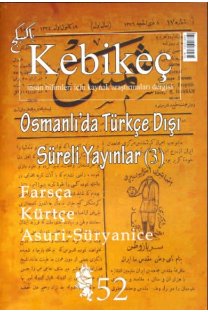Boru Çiçeği ve Söyledikleri
Devil’s Trumpet and Its Tale
___
- A. G. Avery, Historical Review, Blakeslee: The Genus Datura, The Ronald Press Company, New York, 1959 (içinde), s. 3-15.
- D. Symon ve L. Haegi, “Datura (Solanaceae) is a new world genus”; Solanaceae (içinde), J. G. Hawkes, R. N. Lester, M. Nee ve N. Estrada-R. (Editörler), Kew: Royal Botanic Gardens and London: Linnaean Society, s. 197–211, 1991.
- F. B. Kilmer, “The Daturas”, Am. Jour. Pharm., 102: 526-534, 1930.
- H. E. Driver ve W. C. Massey, “Comparative Studies of North American Indians”, Transactions of the American Philosophical Society, 47 (2): 165- 456, 1957.
- J. Dupin ve S. D. Smith, “Phylogenetics of Datureae (Solanaceae), including description of the new genus Trompettia and re-circumscription of the tribe”, Taxon, 67: 359–375, 2018.
- J. Dupin ve S. D. Smith, “Integrating historical biogeography and environmental niche evolution to understand the geographic distribution of Datureae”, American Journal of Botany, 106: 667–678, 2019.
- J. M. Cooper, “Stimulants and narcotics. The Comparative Ethnology of South American Indians”, Smithsonian Instit. Bull. 143, cilt 5: 525-558, 1949.
- M. Jiao, M. Luna-Cavazos ve R. Bye, “Allozyme variation in Mexican species and classification of Datura (Solanaceae)”, Plant Syst. Evol., 232: 155–166, 2002.
- P. Soni, A. A. Siddiqui, J. Dwivedi ve V. Soni, “Pharmacological properties of Datura stramonium L. as a potential medicinal tree: An overview”, Asian. Pac. J. Trop. Biomed., 2: 1002- 1008, 2012.
- Blakeslee: The Genus Datura, The Ronald Press Company, New York, 1959.
- R. Beverley, The History and Present State of Virginia, 1705.
- R. Geeta ve W. Gharaibeh, “Historical evidence for a pre-Columbian presence of Datura in the Old World and implications for a first millennium transfer from the New World”, J. Biosci., 32: 1227–1244, 2007.
- S. Satina, A. Avery ve M.-H. Satchet, “A Review of the Taxonomic History of Datura”, Blakeslee: The Genus Datura (içinde), The Ronald Press Company, New York, 1959, s. 16- 48.
- www.tubives.com. W. H. Freeman vd., Introduction to Genetic Analysis, 11. Ed., 2015, 632.
- Y. Yang, D. Yuanye, L. Qing, L. Jinjian, L. Xiwen ve Wang Yitao, “Complete Chloroplast Genome Sequence of Poisonous and Medicinal Plant Datura stramonium: Organizations and Implications for Genetic Engineering”, PLoS ONE, 9 (11): e110656. doi: 10.1371/journal.pone.0110656, 2014.
- ISSN: 1300-2864
- Yayın Aralığı: 2
- Başlangıç: 1995
- Yayıncı: Mehtap Yüksel
Reji Dönemi Tütün Kaçakçılığının Toplumsal Anlamı ve Temsilleri*
Şaraplık Mayanın (Saccharomyces cerevisiae) Genetiğinden Evcilleştirme Tarihine Kısa Bir Bakış
Uyuşturucu Kullanımı Üzerine Sosyolojik Araştırmaların Bibliometrik Analizi
İrem ÖZGÖREN KINLI, Onur KINLI, Dilek ÖZDEMİR GÜNGÖR
İran’da Mirza Melkom Han’ı Hatırlamak*
Vatanına Hürmet Eden İçki İçmez: Osmanlı Men-i Müskirat Cemiyeti ve Nizamnamesi
“Âdî Kenevirin Bir Dürlüsü”: Son Dönem Osmanlı İmparatorluğu’nda Esrar
Sınır Taşlarından Dikenli Tel ve Mayına: Türkiye-Suriye Sınırının Kalınlaşması*
Dr. Haçig Boğosyan ve Turkio Hagalkolagan Ingeragtsıtyun [Türkiye Anti-Alkolikler Birliği]
